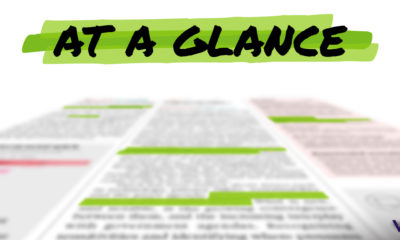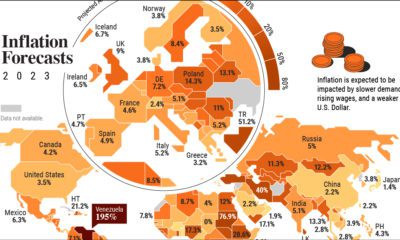
Written By Govind Bhutada
Graphics & Design
- Zack Aboulazm
Published February 15, 2023
•
Updated February 15, 2023
•
TweetShareShareRedditEmail
The following content is sponsored by CanAlaska Uranium
Visualizing the Past and Future of Energy Transitions
As the world gears up for clean energy, looking back at the history of energy transitions can help identify lessons for the future.
What have shifts in the global energy system looked like in the past, and how can we accelerate the ongoing transition?
The above infographic sponsored by CanAlaska Uranium explores the history of shifts in the global energy mix and highlights the key to a faster clean energy transition. This is Part 1 of 4 in the Road to Energy Utopia series.
Energy Transitions: A Brief History
Prior to the 1800s, people mainly relied on biomass like wood, dry leaves, and charcoal for heating and energy. Carriages driven by animals were the primary means of transport.
The first energy transition, from biomass to coal, began with the Industrial Revolution. This shift was largely driven by the rise of coal-fired steam engines, which found their way into railways, factories, and ships.
To put that into perspective, here are the shares of different energy sources in the global energy mix since 1800:
| Year | Traditional Biomass |
Renewables | Nuclear | Coal | Oil | Gas |
|---|---|---|---|---|---|---|
| 1800 | 98% | 0% | 0% | 2% | 0% | 0% |
| 1850 | 93% | 0% | 0% | 7% | 0% | 0% |
| 1900 | 50% | 0% | 0% | 47% | 1% | 1% |
| 1950 | 26% | 3% | 0% | 44% | 19% | 7% |
| 2000 | 10% | 7% | 6% | 22% | 35% | 20% |
| 2021 | 6% | 13% | 4% | 25% | 29% | 23% |
The rise of coal was followed by that of oil, which became a dominant energy source after World War II. Simultaneously, countries invested in infrastructure and gas pipelines, enabling widespread use of natural gas for heating and electricity.
Alongside economic factors, technological innovations were the catalysts of these energy transitions, which occurred over centuries. For example, the invention of gas-powered automobiles and assembly lines allowed the automobile industry to explode, taking oil consumption with it.
The current energy transition, however, is different. Driven by the threat of climate change, it requires an unprecedented shift away from fossil fuels in a few decades, while energy demand increases. So, how can the world meet this challenge?
Accelerating the Clean Energy Transition
While wind and solar power are at the center of the energy shift, they have a few limitations, including:
- Variability: Electricity generation fluctuates throughout the day due to the reliance on sunlight and wind speeds.
- Geographical barriers: To maximize efficiency, solar and wind plants are often located in remote regions away from centers of demand.
- Land footprint: Due to their low energy densities, solar and wind farms typically use large amounts of land per unit of electricity.
To meet the rising demand for electricity, renewables need to be supported with a reliable energy source, and nuclear power is the perfect pillar.
Why nuclear? For starters, here are some of the advantages of nuclear power in the energy shift:
- Reliability: Nuclear plants are nearly thrice as reliable as wind and solar power plants, based on capacity factors.
- Zero-emissions: Nuclear reactors do not emit any greenhouse gases during operation and are one of the cleanest sources of electricity.
- Safety: Nuclear power is the second-safest source of energy (after solar) based on fatalities per unit of electricity.
- Affordability: Nuclear power plants are cost-competitive with other sources, and large changes in the price of uranium only have a small impact on operating costs.
Consequently, nuclear power is fundamental to achieving climate goals worldwide. In fact, according to the IEA, global nuclear power capacity needs to double for net-zero emissions by 2050.
CanAlaska is a leading exploration company in the Athabasca Basin, the Earth’s richest uranium depository. Click here to learn more now.In part 2 of the Road to Energy Utopia series, we dive deeper into the advantages of nuclear power and its role in enabling a state of energy utopia.

Please enable JavaScript in your browser to complete this form.Subscribe to our free newsletter and get your mind blown on a daily basis: *Sign up
Related Topics: #nuclear power #coal #Gas #renewables #clean energy #fossil fuels #energy transition #history of energy transitions
Click for Comments
var disqus_shortname = "visualcapitalist.disqus.com";
var disqus_title = "Visualizing the Past and Future of Energy Transitions";
var disqus_url = "https://www.visualcapitalist.com/sp/visualizing-the-past-and-future-of-energy-transitions/";
var disqus_identifier = "visualcapitalist.disqus.com-155396";
You may also like
-

Markets1 day ago
Ranked: America’s Best Places to Work in 2023
According to employee reviews on Glassdoor, here’s how the ranking of top-rated employers in the U.S. has changed over the last five years
-

Politics2 days ago
Ranked: The World’s Most and Least Powerful Passports in 2023
How strong is your passport? This ranking showcases the most and least powerful passports based on their ease of access to countries globally.
-

VC+5 days ago
What’s New on VC+ in February?
This month’s VC+ special dispatches feature an in depth look at the IMF’s country report on China and the February edition of Markets this Month.
-

Energy5 days ago
Mapped: Europe’s Biggest Sources of Electricity by Country
As Europe and the EU shift away from fossil fuels, which energy sources are European countries depending on for their electricity generation?
-

Technology6 days ago
Decoding Google’s AI Ambitions (and Anxiety)
In a recent letter, Sundar Pichai reveals more than meets the eye. Here we read between the lines to provide more context into Google’s position on…
-

Markets7 days ago
Mapped: 2023 Inflation Forecasts by Country
Inflation surged on a global scale in 2022, hitting record-level highs in many countries. Could it finally subside in 2023?
Subscribe
Please enable JavaScript in your browser to complete this form.Join the 365,000+ subscribers who receive our daily email *Sign Up
The post Visualizing the Past and Future of Energy Transitions appeared first on Visual Capitalist.